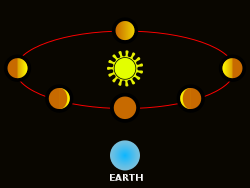General Astronomy/Apparent Motions of the Planets
Before the common acceptance of the heliocentric model in the mid 1500s, the Earth was believed to be the center of the known universe. Many inherent problems in the geocentric model of the universe led Nicolaus Copernicus to formulate an alternate means by which planets and stars moved. Two such problems are the apparent retrograde motion of various planets, specifically Mars, and the ensuing epicycle theory made to compensate for this issue, as well as the phases of Venus that occur.
Planetary Motion and Epicycles
[edit | edit source]
Viewing Earth as the center of our universe, many of the planets in our solar system take on a peculiar motion across the night sky. For instance, Mars appears to move in a retrograde fashion from time to time. Since the geocentric model holds that all the planets in our solar system orbit the Earth, this would mean that from time to time Mars reverses its orbital direction only to resume it later. The Greek astronomer, Ptolemy, sought to explain this phenomenon with the use of epicycles - that is, small circular motions that planets orbiting the Earth followed on top of their circular orbit around the Earth. Astronomers from Greek times to the Enlightenment compensated for flaws in the geocentric model by adding extra layers of epicycles, until the system was so complex it became virtually unusable. Copernicus' heliocentric model, placing the Sun at the center with planets going around it rather than around the Earth, rid the universe of many of the epicycles that plagued astronomy at that time.
Phases of Venus
[edit | edit source]

Another problem with the geocentric model occurred when observing Venus and its relative phases: should Venus and the Sun orbit the Earth, then it would be impossible for Venus to be in the "full" phase, that is complete illumination (similar to a full moon). Thus, the Ptolemaic model predicted only crescent and new phases of Venus. Yet, as Galileo observed, this was clearly not the case; Venus exhibited all phases of the moon, a phenomenon predicted and accounted for by Copernicus' model. Discovered by Galileo, this phenomenon was one of the key factors that would end up supporting the Heliocentric view of the universe.
Note that this is only one of a number of observations made by Galileo that contradicted the ancient beliefs, but this one most directly called into question the idea that planets orbit the Earth.
References
[edit | edit source]- Shea, William R. Galileo in Rome: the Rise and Fall of a Troublesome Genius. New York: Oxford UP, USA, 2004.